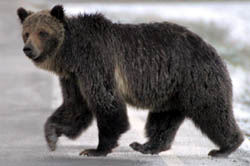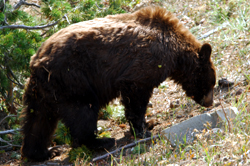Grizzly Bears
Updated: August 7, 2020

Grizzly bear, scientific name Ursus Arctos Horribilis, is probably the most terrifying and awe-inspiring animal in Montana. They have been the subjects of legends for centuries. When standing on their hind legs grizzlies are often over six to eight feet tall and can be three to four feet at the shoulder and weigh about 300 to 800 pounds or more. The grizzly's distinctive features include humped shoulders, a long snout, long curved claws and a silvery back. The humped shoulders are actually a mass of muscle. In spite of their massive size this bear is very agile and runs at speeds of up to 35 mph. They get their name from the grizzled look of their long guard hairs having white tips on their back and shoulders. Being at the top of the food chain, adult grizzly bears have little to fear from other wild animals.
Grizzlies are omnivores meaning they eat both plants and other animals. Their diet varies by the season and includes grasses, roots, berries, nuts, fish and rodents. Aided by their long front claws and massive shoulder muscles, grizzlies are excellent diggers. Grizzlies also eat a great deal of insects, sometimes tearing rotten logs apart and turning over heavy stones in search of insects. They sometimes prey on large mammals but typically their diet consists of less than 10 percent meat. Storing up a lot of body fat is important for the bears to survive hibernation, especially for a female who will give birth to cubs.

Early in the fall grizzly bears begin looking for a proper place to dig their dens for hibernation, and may travel many miles before finding a comfortable winter home. Generally they seek a high mountain slope where a blanket of deep snow will cover their den and serve as insulation until spring. Grizzlies often dig beneath the roots of large trees to create their dens.
Female grizzly bears breed when they reach maturity at about 4 to 7 years old. She will mate between May and July. The young won’t be born until January or February because the fertilized egg does not begin to grow until November, this is called “delayed implantation.” Females will have one to three cubs in early February while hibernating in their winter dens and will wait for spring before they come out and eat again. The female will not breed again until her cubs are on their own.
Grizzly cubs are born blind, toothless, almost hairless, weighing 1 – 2 pounds and just eight inches long. The cubs will remain in the den with their mother until April or May, by that time the cubs will weigh about 20 pounds. Grizzly cubs may fall prey to mountain lions, wolves, and other bears if they stray too far from their mother. They will stay with their mother from 2 to 4 years and she will teach them how to survive.

The destruction of bear habitat has lead to smaller numbers of bears. People have built roads, houses, farms and mines where bears used to live, reducing their natural habitat. Until recent years saving ecosystems and the creatures that live in them was not important to many people. In the past much of the culture in the United States saw nature as something to be tamed or defeated. Research and education have lead many people to reexamine their attitudes toward the grizzly bear.
In the past people killed bears for meat, fur and trophies. It is now illegal to kill grizzlies in the continental United States. They are protected under the Endangered Species Act of 1975, and are listed as a threatened species. During the 1800s, it is estimated that 100,000 grizzly bears inhabited North America from the Mississippi River to the Pacific Coast. There are currently about 800 grizzly bears in Montana. Many of the bears in Montana live in or near Glacier National Park, most of the others live in Yellowstone National Park, and other nearby wilderness areas.
Many bears live in Montana and many people enjoy the outdoors, but surprisingly few people ever see bears. Still there are a few things you can do to just to be careful. Most bears tend to avoid people, so make noise -- talk loudly, sing camp songs or use bells -- to announce your presence. If you do meet a bear move slowly away. Do not run.
Clean camps are essential to reduce bear encounters. The smell of food and trash attracts bears because they have an excellent sense of smell. Keep your dishes, clothing and campsite clean. Keep cooking and sleeping areas of your camp separate and store food in airtight containers.
Updated: August 7, 2020

